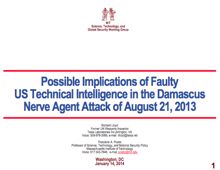
Richard Lloyd, a former UN weapons inspector, and Theodore Postol, a professor at the Massachusetts Institute of Technology (MIT), published a report which challenges the ballistic data used by U.S. intelligence services in connection with the 21 August 2013 massacre in Ghouta, a Damascus suburb.
The authors show that the sarin-laden rockets could not have been fired from a distance of more than 2 kilometers from their point of impact. Based on the intelligence maps published by the Pentagon, they concluded that under no circumstances can Syria be held accountable for the massacre.
They also pointed out that the allegation concerning government airstrikes over the same region during several days is equally untenable for the same reasons.
What is more, the rockets which delivered the sarin gas do not tally with those in the Syrian Arab Army’s arsenal, as ascertained by the OPCW disarmament inspectors (Organisation for the Prohibition of Chemical Weapons).
The experts point to a serious breach on the part U.S. intelligence agencies and demand an explanation in order to avoid a repetition.
Possible Implications of Faulty US Technical Intelligence in the Damascus Nerve Agent Attack of August 21, 2013, by Richard Lloyd and Theodore A. Postol, MIT, 14 January 2014, 46 pp.

















Stay In Touch
Follow us on social networks
Subscribe to weekly newsletter